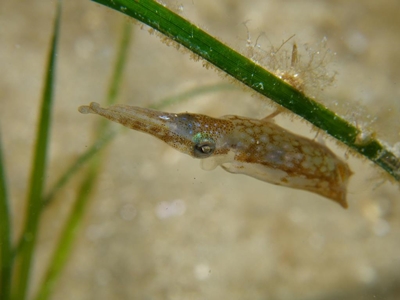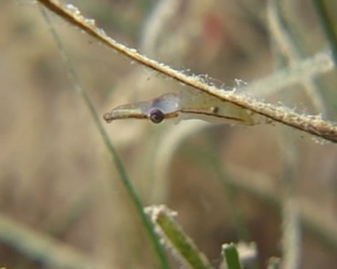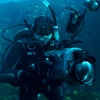General Description
Tiny cylindrical, free-swimming squid. Small pair of rounded fins on the rear tip of body. Large glandular patch on the rear two thirds of upper body. Colour varies from almost transparent, to iridescent green and yellow, to dark chocolate brown. Short white lines radiate from around the eyes. Female mantle length to 3 cm. Male mantle length to 16 mm, some maturing at less than 1 cm.
Biology
Pygmy squids are the smallest of all the cephalopods. This squid is abundant in seagrass beds in bays and inlets, particularly eelgrass beds (Zostera and Heterozostera). It lives deep within the seagrass where it attaches to the underside of leaves using special glue glands situated on the top of its body. The glue gland allows the squid to maintain position without having to be buoyant or constantly swim. Pygmy squids are ambush predators that prey on small crustaceans and fish. They are able to push their mouth parts (beak and toothed tongue) deep into their prey. They are active both during the day and night. Females lay single round eggs in lines along the underside of seagrass leaves.
Habitat
Seagrass beds in shallow bays and inlets to a depth of 20 m.
Seagrass meadows
Distribution guide
Southern Australia.
Species Group
Depth
Water Column
Max Size
1 cm
Diet
Carnivore
Harmful
Potential to bite, especially if handled. Venom status unknown.
Commercial Species
No
Global Dispersal
Native to Australia
Species Code
MoV 2829
Identify
Conservation Status
- DSE Advisory List : Not listed
- EPBC Act 1999 : Not listed
- IUCN Red List : Not listed







